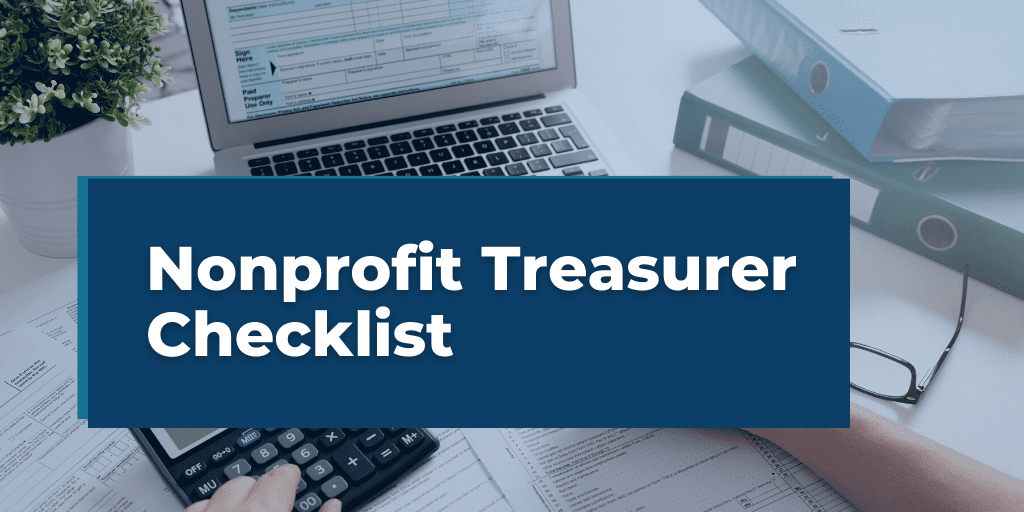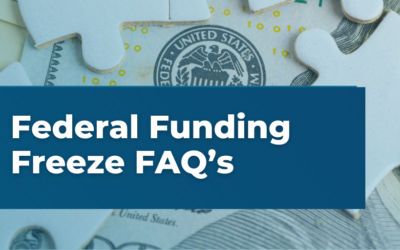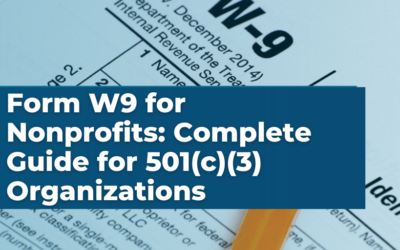Stepping into the role of a nonprofit treasurer is a significant undertaking, tasked with safeguarding the organization’s finances and ensuring they’re used effectively to advance its mission. Navigating the complexities of financial management can be challenging, particularly for those without a deep background in accounting. This is where our “Nonprofit Treasurer Checklist” comes into play.
Designed to simplify financial oversight, this checklist demystifies the treasurer’s responsibilities, providing a clear roadmap for managing your nonprofit’s finances efficiently. From banking and budgeting to compliance and communication, we cover all the essentials to help you succeed in your role.
As you follow this guide, remember your work is crucial in building trust within your community and laying a solid financial foundation for your nonprofit’s future success. Let’s dive in, equipped with the tools and knowledge to make a meaningful impact.
Understanding the Role and Responsibilities
At the heart of the nonprofit treasurer’s role lies the stewardship of the organization’s financial resources. This responsibility extends beyond mere bookkeeping to encompass a broad range of financial management and strategic planning tasks. Understanding these duties is the first step towards effective financial oversight. Here’s what you need to know:
Financial Oversight
- Managing the Finances: You’re responsible for overseeing the organization’s finances, ensuring that funds are managed prudently. This includes monitoring income, expenses, and investments, and making sure they align with the nonprofit’s objectives and budget.
- Risk Management: Part of your role involves identifying financial risks and implementing strategies to mitigate them. This could involve diversifying income sources, establishing reserves, or reviewing insurance coverage.
Reporting and Compliance
- Transparency and Accountability: Regular financial reporting to the board is crucial. These reports should provide a clear picture of the organization’s financial status, including its assets, liabilities, revenue, and expenditures.
- Legal Compliance: Ensuring that the nonprofit complies with all financial regulations and filing requirements, such as IRS filings (e.g., Form 990), is a key part of your role. This not only keeps the organization legally compliant but also maintains its public credibility and tax-exempt status.
Budgeting and Planning
- Blueprint for Success: Creating and managing the annual budget is one of your most important tasks. The budget acts as a financial blueprint, guiding the organization’s activities and ensuring that funds are allocated effectively to meet its goals.
- Strategic Financial Planning: Beyond the annual budget, you’ll be involved in long-term financial planning. This includes setting financial goals, planning for growth, and ensuring the organization’s financial stability and sustainability.
Collaboration and Leadership
- Board Engagement: Collaborating closely with the board and finance committee is essential. Your role includes advising them on financial matters, helping them understand the organization’s financial health, and supporting informed decision-making.
- Teamwork: Working with the executive director and other staff members, you’ll help create a culture of financial accountability and transparency throughout the organization.
Understanding these responsibilities is the foundation upon which effective financial management is built. As a treasurer, your leadership in these areas will not only ensure the organization’s financial health but also its ability to fulfill its mission and make a lasting impact
Setting Up for Success
To ensure the nonprofit’s financial health from the get-go, there are several foundational steps you, as the treasurer, need to take. These steps are designed to establish a strong, transparent, and efficient financial management system. Let’s dive into what this entails:
Establishing Financial Policies and Procedures
- Creating Clear Guidelines: Develop comprehensive financial policies that cover every aspect of financial management, from handling cash to approving expenses. These policies ensure consistency and help prevent misunderstandings or financial missteps.
- Setting Up Systems: Implement procedures for recording transactions, managing donations, and reporting finances. This might include choosing the right accounting software that fits the nonprofit’s needs.
Bank Accounts and Financial Access
- Opening Bank Accounts: Ensure the nonprofit has a bank account in its name. You might also consider having separate accounts for different purposes (e.g., operations, savings, and grants) to keep finances organized.
- Controlling Access: Clearly define who has authority to access the bank accounts, sign checks, and make financial transactions. This is crucial for maintaining security and accountability.
Regular Financial Tasks
As treasurer, your routine tasks are the heartbeat of the nonprofit’s financial management. Regularly attending to these tasks keeps the organization’s finances healthy and transparent.
Bookkeeping
- Accurate Record-Keeping: Maintain detailed and accurate records of all financial transactions. This includes donations received, expenses incurred, and any other financial activities.
- Using Software Tools: Consider using accounting software designed for nonprofits to streamline bookkeeping processes and maintain accurate financial records.
Budgeting
- Annual Budget Creation: Lead the process of creating an annual budget that reflects the nonprofit’s goals and priorities. This involves collaborating with staff and board members to ensure the budget aligns with the organization’s mission and objectives.
- Budget Monitoring: Regularly compare actual income and expenses against the budget to monitor the organization’s financial health. Adjustments may be needed to keep the nonprofit on track.
Financial Reporting
- Regular Updates: Prepare and present clear, concise financial reports to the board on a regular basis. These reports should include information on the nonprofit’s financial status, budget performance, and any financial challenges or opportunities.
- Transparency: Ensure financial reports are accessible to stakeholders, fostering a culture of transparency and accountability.
Cash Flow Management
- Monitoring Cash Flow: Keep a close eye on the nonprofit’s cash flow to ensure there are sufficient funds available to cover operational needs and fulfill financial commitments.
- Planning for Variability: Anticipate and plan for seasonal fluctuations or unexpected expenses to maintain financial stability.
By establishing solid financial foundations and diligently performing regular financial tasks, you’ll ensure the nonprofit operates efficiently, remains financially healthy, and continues to make a positive impact on the community it serves.
Compliance and Legal Requirements
Navigating the maze of compliance and legal requirements is a crucial part of a nonprofit treasurer’s role. Staying on top of these obligations ensures your organization operates within the law, maintains its tax-exempt status, and upholds the trust of its supporters. Here’s a simplified guide to what you need to know:
Tax Obligations: More Than Just Filing Forms
- Understanding Tax-Exempt Status: Know the ins and outs of your nonprofit’s tax-exempt status. This includes what activities you can engage in without jeopardizing this status and how to properly report income and expenses.
- Annual IRS Filings: Familiarize yourself with Form 990 and other relevant tax documents. These forms are not just about taxes; they’re also a way to showcase your nonprofit’s work, financial health, and commitment to transparency.
Regulatory Compliance: Keeping It Legal
- Staying Informed: Keep up with changes in federal, state, and local laws affecting nonprofits. This might include fundraising regulations, employment laws, and financial reporting requirements.
- Document Retention: Implement a policy for keeping important documents, like financial records, board meeting minutes, and legal filings. Knowing what to keep (and for how long) is essential for compliance and can be invaluable during audits or legal inquiries.
Audit Preparation: More Than Just a Checklist
- Understanding the Need: Recognize when your nonprofit is required to have an audit, which is often based on your revenue level or grantor requirements. Even if not required, voluntary audits can be a good practice for financial transparency.
- Preparing for the Audit: Ensure your financial records are accurate and up-to-date. Work with your team to gather necessary documents and information ahead of time. This not only facilitates the audit process but also reflects well on your organization’s management practices.
Engaging with Stakeholders
Effective communication and engagement with stakeholders are pivotal for a nonprofit treasurer. This involves more than just presenting numbers; it’s about telling the story behind those numbers and how they contribute to your organization’s mission.
Board Communication: Building Trust through Transparency
- Educating the Board: Use financial reports and meetings as opportunities to educate board members about the organization’s financial status, challenges, and opportunities. This helps them make informed decisions and serve as better advocates for your nonprofit.
- Strategic Discussions: Engage the board in strategic financial planning discussions. This can help align financial goals with the organization’s mission and long-term vision.
Donor Reporting: Demonstrating Impact
- Transparent Reporting: Provide donors with clear and concise financial reports that demonstrate how their contributions are being used. This can help build trust and encourage ongoing support.
- Telling the Story: Remember, financial reports to donors are not just about numbers. They’re an opportunity to share the impact of their donations, connecting financial data with real-world outcomes.
By embracing these compliance, legal, and engagement responsibilities, you not only safeguard your organization’s integrity and trustworthiness but also strengthen its ability to fulfill its mission. Remember, the ultimate goal is not just to manage finances effectively but to use those resources to make a difference in the communities you serve.
Tools and Resources
Equipping yourself with the right tools and resources can significantly streamline your nonprofit’s financial management tasks, making them more efficient and less time-consuming. This section highlights some essential tools and resources that can help you fulfill your treasurer duties more effectively.
Accounting Software for Nonprofits
- Specialized Software: Look for accounting software designed specifically for nonprofits. These tools can handle fund accounting, grant tracking, and donor management, which are unique to the nonprofit sector.
- Popular Options: Consider reputable platforms like QuickBooks Nonprofit, Sage Intacct, and Xero, which offer features tailored to nonprofit needs, such as generating donation receipts and detailed financial reporting.
Online Resources and Learning Platforms
- Financial Management Guides: Websites like the National Council of Nonprofits and the Nonprofit Finance Fund offer guides, articles, and webinars on nonprofit financial management best practices.
- Professional Development: Platforms like Coursera and edX provide courses on nonprofit management, accounting, and finance, allowing you to deepen your understanding and skills at your own pace.
Networking and Professional Associations
- Joining Nonprofit Networks: Local and national nonprofit associations offer networking opportunities, workshops, and conferences that can provide valuable insights and connections.
- Professional Finance Networks: Consider joining professional finance networks or associations, such as the American Institute of Certified Public Accountants (AICPA) Nonprofit Section, for access to resources, training, and peers specializing in nonprofit finance.
Templates and Checklists
- Budget Templates: Utilize free budget templates designed for nonprofits to streamline your budgeting process. These can often be found through a quick online search or on nonprofit resource websites.
- Financial Policies Checklist: Implementing strong financial policies is crucial. Look for checklists online that can guide you through the creation of policies tailored to your organization’s size and complexity.
Conclusion
Managing a nonprofit’s finances might seem daunting, but with the right preparation and resources, it’s entirely feasible. This checklist is designed to provide a solid foundation for your role as a treasurer, ensuring that you’re well-equipped to oversee your organization’s financial health. Remember, the goal isn’t just to keep the books balanced but to enable your nonprofit to thrive and maximize its impact.
If you’re looking for more personalized advice or have specific questions about nonprofit financial management, don’t hesitate to reach out to Velu for a deeper discussion. With the right support and resources, you can navigate the financial complexities of your nonprofit with confidence and clarity.





